Friday, September 15, 2006
Æ32, Corycus in Cilicia, Valerian, SNG von Aulock 5686
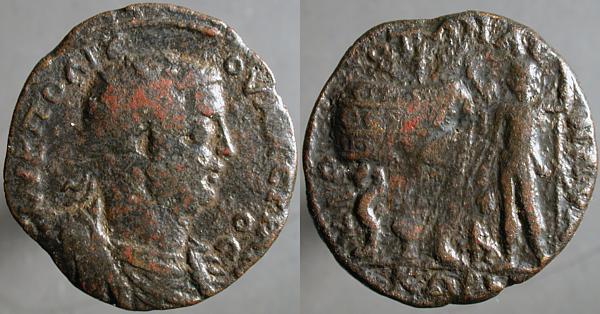
AV K ΠO OVAΛEPIAN / OC, Radiate draped cuirassed bust right | KOPV / KIΩ_TΩN AV NAVAP[X / IC], Prize crown, marked ΘE[MIΔ], palms protruding, on three-legged table, Dionysus right, standing left, holding grape cluster in right hand and thyrsus with right. Panther with head reverted standing at feet.
I've seen a few examples of this substantial coin at auction in the last few months, some of them in nicer state than this, but not enough nicer to prompt me to make a reasonable bid. It's a big world with lots of coins that I want. Upgrades are largely a delay in me being able to afford another one that I don't have at all.
Thursday, September 14, 2006
Billon antoninianus, Valerian II, Rome, Göbl 261k
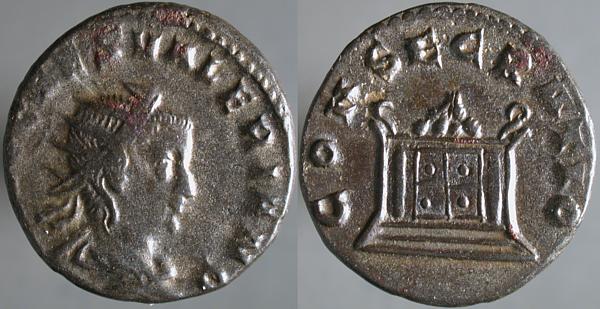
DIVO CAES VALERIANO, Radiate draped bust right | CONSECRATIO, Shrine with flame.
I'm not sure how I missed posting this before, though I have posted version with a different style bust.
Reverses like these are often seen in the 3rd Century on issues for dead emperors and princes. Often called a "pyre," the structure is, I think, better described as a shrine, part of worship by the imperial cult but not part of the cremation of the body, the flame a similar idea as the eternal flame that burns at some modern memorials.
Wednesday, September 13, 2006
Æ2, Valentinian II, Constantinopolis, RIC 79(a)1
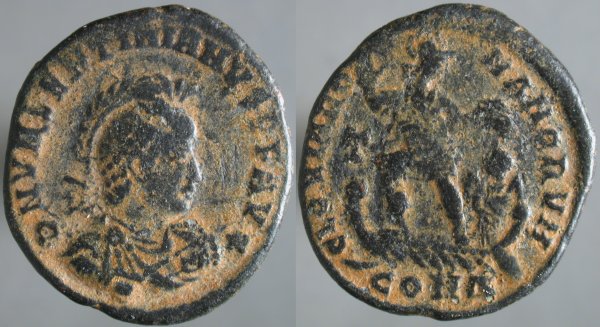
D N VALENTINIANVS P F AVG, Diademed draped cuirassed bust right, wearing crested helmet, holding spear and shield in front. | GLORIA ROMANORVM, Emperor standing left on galley, head right, Victory at the helm. T in left field, CONΔ in exergue.
Flavius Valentinianus was the youngest son of Valentinian and became emperor at the insistance of the army, on his father's death.
After various intrigues with the usurper Magnus Maximus, Valentinian fled Rome and sought help from Theodosius, who had been raised to emperor by Gratian.
After Theodosius had cleaned up the Maximus problem he stayed in the Western part of the empire and left Valentinian in the care of Arbogast, his magister militum. Arbogast and Valentinian quarrelled, Valentinian dismissed Arbogast, Arbogast declined the dismissal and a short time later Valentinian's dead body, some say swinging from a rope, was discovered in the imperial palace.
Tuesday, September 12, 2006
Æ23, Nicomedia in Bithynia, Salonina, ...
Recueil Général des Monnaies Grecques d'Asia Mineure 416
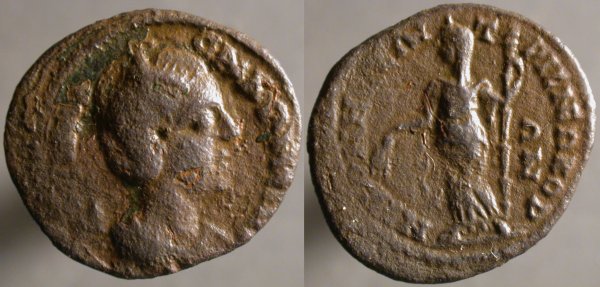
[KOPN CAΛ_]ΩNEINA, Diademed draped bust right | NIKOMH[ΔEΩN] T_PIC NEΩKOP / ΩN, Demeter standing left with grain-ears in right hand and torch in left.
There are, on the internet, some venues very well-suited to helping people fully identify an ancient coin in their collection. Two in particular are FORVM's Classical Numismatic Discussion Board and the Moneta-L discussion list, probably best accessed as a mailing list.
When I've gotten help from these resources, I've paid particular attention to the catalogs used and wound up buying some quite obscure references, some not only in languages I don't understand but a few in alphabets I can't read.
French, of course, uses the familiar Roman alphabet and Recueil Général des Monnaies Grecques d'Asia Mineure, W.H. Waddington, E. Babelon, Th. Reinach was twice part of the answer to coins I couldn't fully identify. This coin, which I obtained today, I was able to identify myself using this book, and no other that I own.
It's a dated but very useful two-volume set written between 1904 and 1912 and left partially finished, stopped when political instability during the run-up to the First World War made continuing impossible. Classical numismatics is full of brilliant projects interrupted by reality.

[KOPN CAΛ_]ΩNEINA, Diademed draped bust right | NIKOMH[ΔEΩN] T_PIC NEΩKOP / ΩN, Demeter standing left with grain-ears in right hand and torch in left.
There are, on the internet, some venues very well-suited to helping people fully identify an ancient coin in their collection. Two in particular are FORVM's Classical Numismatic Discussion Board and the Moneta-L discussion list, probably best accessed as a mailing list.
When I've gotten help from these resources, I've paid particular attention to the catalogs used and wound up buying some quite obscure references, some not only in languages I don't understand but a few in alphabets I can't read.
French, of course, uses the familiar Roman alphabet and Recueil Général des Monnaies Grecques d'Asia Mineure, W.H. Waddington, E. Babelon, Th. Reinach was twice part of the answer to coins I couldn't fully identify. This coin, which I obtained today, I was able to identify myself using this book, and no other that I own.
It's a dated but very useful two-volume set written between 1904 and 1912 and left partially finished, stopped when political instability during the run-up to the First World War made continuing impossible. Classical numismatics is full of brilliant projects interrupted by reality.
Monday, September 11, 2006
Æ barbarous radiate, Gallienus, unknown location, cf. Göbl 585a
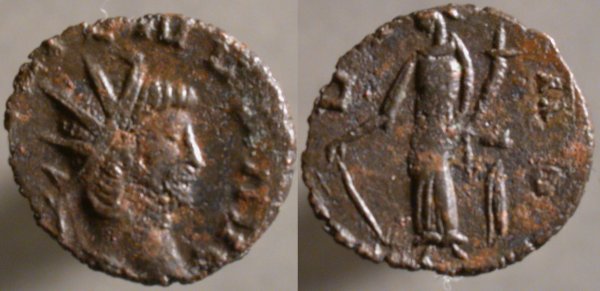
[...]IENVS AVG, Radiate head right | V[.] AG, Fortuna standing left, holding rudder in right hand, and cornucopia in left. Drapery from left elbow mistaken for column.
I remain somewhat of two minds about incorporating these barbarous coins into my collection: they're a valid view of one aspect of the money of the era, or just after, but there remain unresolved questions as to whether (or to what extent) these were counterfeits made to deceive or whether they were money of convenience, a medium of exchange used by people in cash-starved areas.
I'm enough of a Yankee to resent paying for ancient counterfeits, but money of convenience seems fair, like collecting cowry beads or clam-shell wampum.
My examples of various ancient imitations of Roman coins here.

